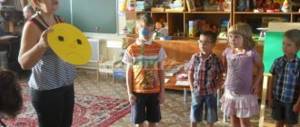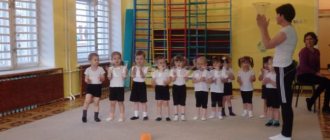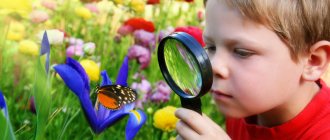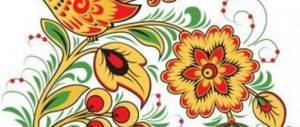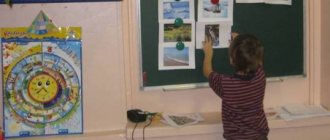MAGAZINE Preschooler.RF
Familiarizing younger preschoolers with the work of adults.The peculiarity of introducing younger preschoolers to the work activities of adults is based on the inextricable unity with children’s knowledge of the man-made world. The things and toys that surround babies are of particular importance in the development of young children. Younger preschoolers actively enter the man-made world and begin to get acquainted with a large number of objects in everyday life, play and other types of children's activities. Children of this age actively experiment with both objects and materials, discovering, for example, that paper gets wet in water, a rubber ball is elastic, and jumps high if it is hit hard on the floor. Young children are attracted by the brightness and colorfulness of the objective world, which allows the teacher, based on the emotional and sensory experience of children, to help develop a value-based attitude towards the objective world.
However, most children do not see the focus of their work on results. All components of work activity are merged for them and are not perceived separately. That is why children cannot even talk about the labor processes that are carried out before their eyes every day. Teachers of younger groups introduce them to specific work processes that are performed by people working in kindergarten. At the first stages, supervision of the activities of the assistant teacher is organized: the nanny washes the dishes, sets the table, distributes food, washes the floor, wipes the dust. In the course of observing specific processes of household labor of adults, the teacher reveals to children the purpose and motives of their activity, focusing attention on each component of work, explaining their necessity.
The first component of work is goal setting and motivation of the work process. In order for children to understand the need for work and to understand the motives of adults’ activities, the teacher constructs a variety of everyday educational situations that are a natural part of the pedagogical process of the kindergarten.
For example, the tables are not set - you cannot dine, a dirty cup cannot be drunk from it. The junior teacher will take care of this. Thus, the motive of work and its significance are revealed to children through awareness of their own needs. Children's attention is directed to obtaining the result of their work.
The second component of labor - the selection of objects of labor is carried out in front of the children: the teacher offers to help the junior teacher collect dirty dishes from the tables, remove towels from the hanger, etc. This makes it possible to make our children in the labor process, assistants to adults.
The third component of labor is labor equipment. Carrying out the labor process, an adult selects the equipment necessary for its implementation, shows it to the children, names it, and the teacher provides choral pronunciation so that the names are better remembered by the children. At the same time, he pays attention to the organization of the labor process, how the adult prepared for work, why he put on an apron, why he rolled up his sleeves, etc.
The fourth component of labor is the composition and order in which adults perform labor actions. It is important that kids get a general idea of the sequence of actions, their chain. In the younger group, only the most significant of them are highlighted, and the labor process is simplified. Every significant work action is shown, explained and motivated in a form accessible to children.
For example; The nanny shows how she washes the cup: she carefully rubs it from the inside, then from the outside, the bottom, at the handle. She rubs until the cup is clean. The dirt has been wiped off, but you can’t drink from the cup, what should you do?” - the teacher asks a question. Observing the actions of the junior teacher, children answer the question posed.
The main methods of labor education are: observation of fragments of specific types of work, observation of household work, experimentation, examination of objects and pictures, didactic games (Shop, Wonderful Bag)
etc., reading poems and nursery rhymes, game situations
(Let's dress the doll for a walk)
, role-playing games.
| Next > |
Lesson on labor education in the junior group “We wash handkerchiefs”
Municipal budgetary preschool educational institution
"Kindergarten No. 2"
Competition of methodological developments in labor education
Summary of OOD in the junior group
Subject:
“We will wash the handkerchiefs”
Author: I.A. Klyueva, teacher
I
qualification category
Ardatov, 2017
Target:
develop basic labor skills and abilities, promote mastery of methods for examining objects through experimentation in the process of organizing children's activities.
Tasks:
- develop neatness skills and the ability to notice disorder in clothing;
- encourage to provide assistance to adults, to cultivate a caring attitude towards the results of their work;
- to form in children the practical actions that they need to put things in order (washing);
- include children in joint practical cognitive activities of an experimental nature with adults;
- develop children's speech and enrich their vocabulary.
Integration of educational areas:
social - communicative development, cognitive development, speech development.
Materials for the lesson:
doll, box with objects (soap, book, towel, car, telephone, picture of a basin with water), tape recorder, audio recording of the game “We will wash handkerchiefs,” basins with water, soap, soap dishes, napkins, waterproof aprons, handkerchiefs, floor drying for linen, clothespins.
Novelty
methodological development lies in the integration of labor and experimental activities of children in the organization of common labor.
OOD progress:
The teacher draws the children's attention to the arriving doll Katya. She sneezes.
Educator:
- Katya, why are you sneezing?
Guys, what happened to Katya? (children's answers).
Where's your handkerchief?
(Katya shows a dirty handkerchief)
Teacher:
- Guys, look, is it possible to wipe your nose with such a handkerchief?
(children's answers)
.
Guys, what needs to be done to make the handkerchief clean? (children's answers)
. Of course, the handkerchief needs to be washed.
Katya doll:
- Oh, I don’t know how to do laundry.
Maybe you can teach me? (children's answers).
Educator:
“Of course, we’ll teach you and help you wash your handkerchief.” Guys, first, let's show Katya what items are needed for washing.
I have a magic box, there are a lot of useful things in it, I will take them out, and you tell me which ones we will need for washing.
The teacher takes soap, a towel, a typewriter, a book, a phone, a picture of a basin of water from the box one by one - the children determine what is needed for washing.
Educator
: Now let's play and show the doll how to wash handkerchiefs.
An audio recording of the game “We Wash Handkerchiefs” is played.
We will wash the handkerchiefs
Let's rub them really hard. Fingers clenched into fists, rubbing fist against fist.
And then, and then we’ll wring out the handkerchiefs,
Let's squeeze it very hard. We wring out the laundry.
And then, and then we’ll carry it to the rope
That's it, that's it, we'll carry it to the rope! They hang laundry on a line.
Now let's iron the scarves
On a board with an iron. They move their fist over the palm of the other hand.
Like this, like this on a board with an iron.
Educator:
Guys, now let's wash our handkerchiefs.
Just let’s put on aprons first, why do you think? (children's answers).
Children approach basins filled with water. On the table there is a soap dish with soap, handkerchiefs, towels, napkins
Educator
: Take the soap, touch it, smell it, what kind of soap?
(smooth, dry, fragrant)
.
Look, there are basins of water on the table. We put our palms in the water. What kind of water? Can you see your palms? So what kind of water is it? ( transparent, warm)
.
Dip the soap into the water, then pick it up in your hands. What has it become? (slippery)
.
Guys, who would you help at home if you knew how to do laundry? Would you like to learn how to do laundry to help your mom? Have you seen how your mothers wash clothes? What do you think should be done first? (we put them in the water and wet the handkerchiefs).
Repetition of all actions by children under the guidance of a teacher.
Educator
: Yes, first we lower the handkerchief into the water.
Wet. Now take the soap and lather the handkerchiefs. Is there foam? What kind of foam is this? Wash carefully so that soap does not get into your eyes. Soap causes a burning sensation. I also want to remind you that you need to remember to keep a handkerchief over the basin while washing. Do not spill water on tables. We put the soap and three firmly, firmly with both hands. We rub it and put the handkerchiefs into the water. Let's rinse our handkerchiefs. Look how the water has become? (children's answers).
Educator:
Yes, the water became cloudy, dirty, soapy.
Wring out the handkerchief. Now let's see, have our handkerchiefs been washed? We straighten the handkerchief. Clean? We take the handkerchief again and rinse it in clean water. We squeeze it out, go to the string, shake the handkerchief and hang it on the string. What will we use to hang the scarf? (children's answers)
. Now let's go to the chairs and wipe our hands. We hang towels on the chairs and take off the aprons.
The teacher leads the children to the hanger.
- Look, guys, how great we are, our handkerchiefs were dirty, but what are they now? (children's answers.)
What have we done for this? Do you think Katya will be happy to see that we washed her handkerchief? Who else will be glad that you and I learned how to do laundry? Now you know how to do laundry and can help your mother. What do you need first for this? And then? Well done guys, everyone worked hard. Katya, now have you remembered that you only need to use a clean scarf? Now you know how to wash handkerchiefs.
Katya doll:
Thank you. Now I know how to do laundry, and I will never use a dirty handkerchief. I have prepared a gift for you - soap bubbles.
Educator:
Guys, let's say thank you to the doll. Let's put her to bed so she can rest and recover, and let's go play with soap bubbles.
Photo report
Summary of a lesson on manual labor in the 2nd junior group “Old Lesovichok came to visit us”
Summary of a lesson on manual labor in the 2nd junior group “Old Lesovichok came to visit us”
Software tasks:
1.
Continue to develop in children the desire to engage in manual labor and use skills in working with natural materials.
2.
To foster friendly relationships and love for nature in children;
3.
To develop in children the ability to work together on one topic while completing a specific task;
4.
Continue to teach children how to create crafts from natural materials.
Material:
Toy Old Man Lesovichok, fir and pine cones, shells, plasticine, walnut shells, cotton wool, moss, various seeds. Bunny hats. Recordings of bird voices, forest noise. Layout "Forest Clearing"
Progress of the lesson.
Educator:
Children, I was walking to kindergarten and suddenly I saw a little man in our yard sitting under a tree. I talked to him and invited him to visit us. Now I’ll read poems about him.
There lived a forest boy in the forest, a very wise old man, He commanded the entire forest with the greatest interest. Everyone respected grandpa, Everyone pleased grandpa: The squirrels collected cones, The hares planted vegetables, The medic bees hunted, The mice collected grain, The wolves guarded the house, The bear with the nickname Mikhail was his right hand... So the year goes by, Grandfather lives in the forest, The old man forester Very nice guy.
(E. Danilova)
Let's get to know him.
The teacher takes out the Old Lesovichka and greets the children.
Old Forester:
I came to you from afar. Guess where I live?
The house is open on all sides,
It is covered with a carved roof,
Come to the green house
You will see miracles in it. (Forest)
In my protected forest, all sorts of miracles happen. But the trouble is, all the animals and birds have disappeared somewhere! And I wanted to invite them to the New Year tree! Children, maybe you know where they are?
Children give their guesses.
Old Forester:
Guys, how many of you know poems about my forest?
Children read poetry.
1.
Hello forest! A dense forest, full of fairy tales and miracles! Who is hiding in your wilderness? What kind of animal? What bird? Open everything, don’t hide it: You see, we are our own. (S. Pogorelovsky)
2.
It's good in the forest in winter,
The forest is decorated with fringe,
The ringing snow sparkles,
The frost turns silver.
3.
The wind flew through the forest, The wind counted the leaves: Here is an oak one, Here is a maple one, Here is a carved rowan tree, Here is a golden one from a birch tree, Here is the last leaf from an aspen tree The wind threw it onto the path. (N. Nishcheva)
Old Forester:
Children, I brought you a corner of the forest as a gift.
It is not simple, but magical. Just help me find my friends in it. (gives the teacher a model of a winter forest)
The teacher places the Lesovik unnoticed in a corner of the forest.
Educator:
Guys, I know! We can make them, and they will probably come to life. After all, the forest is magical.
Labor activity file
Labor activity in the younger group is aimed at consolidating the everyday aspects of a healthy person’s life. The children in the second junior group cannot yet be called independent; many of them already know how to perform some everyday tasks without outside help: take off their shoes, take off their hats, put their clothes in a locker. But there are children who cannot cope with such tasks on their own. In order to help them learn to perform some feasible actions alone, as well as to assist a friend in some simple matters, educators conduct games that develop work activity.
Kids are playing
For each school year, teachers draw up notes with a plan of tasks that a child at his age is able to complete. For younger groups, these could be the following activities:
- for girls - playing mother-daughter with a doll that is dirty and needs a bath;
- for boys - a game of car wash, where construction vehicles enter;
- for everyone - wet cleaning of the play rack in order to expel the mud bug from the group, which spoils the toys;
- for everyone - in the summer, after a walk, washing not only your hands, but also your feet, so as not to introduce dangerous bacteria into the bed and into the group.
Washing toys
Approximate list of work assignments
Tasks that are feasible for children of the second junior group and should already be fully mastered:
- hand washing;
- removing used dishes to a specially designated place;
- putting toys back in their places after playing;
- straightening wardrobe items for changing clothes (the skill of turning out pants or tights, identifying the front and back sides, the front and back of clothes);
- teeth cleaning;
- putting the bed in order after sleep (make up).
General instructions
Household labor, used in the second junior group, in most cases is of a collective nature. All together the guys do several useful things, joining the world of adults. At the same time as playing, children learn to clean up dishes after themselves, be careful with wardrobe items, and take care of indoor plants. As a result of successfully teaching a conscious attitude towards their property, which should only be put away in their own locker, children no longer scatter their clothes after a walk, but fold them neatly.
Cleaning dishes
Raising respect for order in children creates the habit of thinking rationally and creating a sequence of actions to achieve the best result. After each meal in the dining room, the children all clean up the dishes together, taking them to a specially designated table.
Labor education at school
Interesting! Boys are quicker than girls to understand that if small objects (spoons and forks) are placed on a plate, they will have to go to the table and back fewer times. Girls will try to simplify their work by just watching the boys.
Individual orders
The goal of individual work is to independently implement the assigned task without the opportunity to spy on a friend or do something together. The favorite activity of girls, caring for indoor plants, is not of interest to most boys, but tasks cannot be divided by gender, because boys must also learn care and respect.
Planning of work activities
It is difficult to make children understand the importance of this or that everyday action the first time if you just talk about it.
Interesting! Labor must be played. Children's interest in play helps to learn the importance of daily activities and instill responsibility for their implementation.
Playing the “Mashu-Zamorasha doll” firmly reinforces the obligation to perform hygienic procedures - wash your hands before eating, brush your teeth after eating, wash before going to bed. The teacher brings a dirty doll into the group and asks to tell Masha why it is so important to keep the body clean.
During walks in winter, children are taught to take care of birds that remain for the winter. For this purpose, they distribute food that children feed to pigeons and sparrows. In addition to caring about nature, the teacher talks about how snow, although cold, warms the rhizomes of trees during severe frosts and strong winds. Pupils are offered to move snow from paths and benches under the trees growing on the territory of the kindergarten. Thanks to such work and care, benches and sidewalks become cleaner, and trees endure winter more easily.
Winter labor
